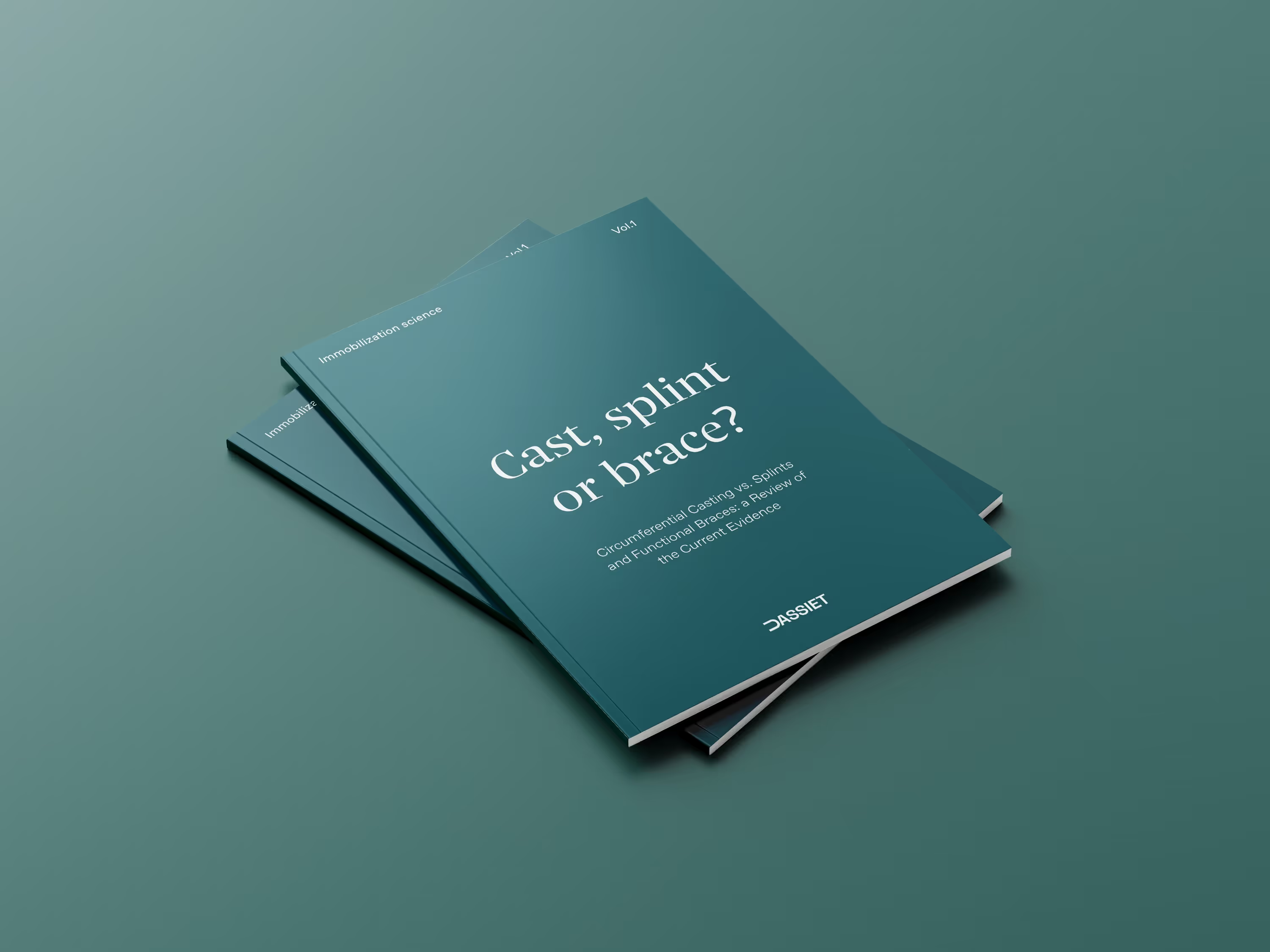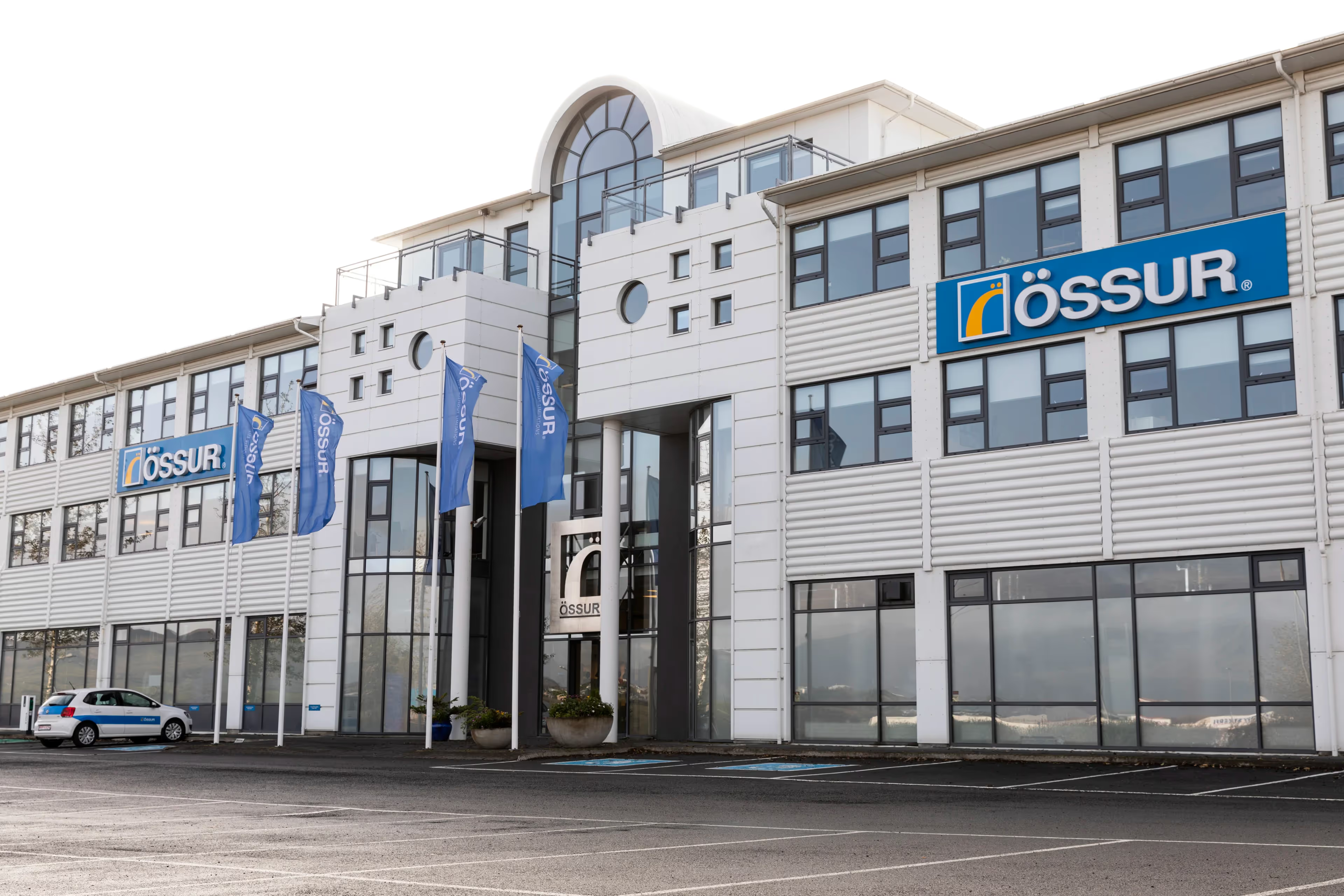Do splints, casts and braces lead to different outcomes? In this article, we look at the scientific evidence. This is a summary of our white paper called “Circumferential Casting vs. Splints and Functional Braces: a Review of the Current Evidence”, which can be downloaded from the link below.
The available evidence consists mostly of small RCTs, of which many are either methodologically flawed or underpowered to provide robust results. However, many studies on several different fracture types show the same pattern – that there were no marked differences at 1-year follow-up.
Would you like to read the full literature review? Download it here
Splints and braces produce the same results as traditional casts, with less risk
The most rigid immobilization method is circumferential casting. The industry staple has many benefits, but also some downsides that are worth considering in light of new research.
The most significant risk reduction seen in less rigid immobilization methods was the reduction in cases of deep vein thrombosis. Based on existing research, both treatment methods seem equally efficient and produce similar healing results. In other words: Less rigid treatment methods are as effective at promoting healing while reducing the risks associated with stiff, cast-type methods.
While full casts ensure rigid and secure fracture support, they do not provide any room for swelling, which can cause complications such as compartment syndrome [1]. There is also a greater risk of harm with circumferential casting. Full casts can leave the joint completely immobilized for a prolonged time. This can cause joint stiffness and muscle atrophy, which may increase the risk of deep vein thrombosis. [2]
For example, a non-inferiority trial on Weber type-B fractures found that the only clinically significant difference in treatment with a functional ankle brace or a below-knee circumferential cast was eight cases of deep vein thrombosis in the casting group (n=84) versus zero in the ankle brace group [3].
What are the most common complications of immobilization treatment? How to avoid them? Follow us on LinkedIn to stay up to date – our next literature review will be covering the evidence on casting complications.
Comparing Immobilization Methods
Organizations are already adapting their research and treatment recommendations to allow for the benefits of less rigid immobilization. For example, the American Academy of Orthopaedic Surgeons (AAOS) recommends removable splints as a treatment option for minimally displaced distal radius fractures that do not require reduction [4].
A study found that removable splints were just as effective as traditional casting in cases of minimally angulated greenstick or transverse fractures of the distal radius in children. However, patients preferred the splint, as it was more comfortable than a full cast [5].
Less rigid immobilization allows beneficial micro-movements
Some biomechanical studies also suggest allowing fracture micro-movement can be beneficial to healing when compared to those given a fixed frame [6,7]. These studies saw that micro-movement produced differences in healing times that were statistically significant, and there was no difference in complications between the two groups.
Micro-movement helps to initiate the growth of callus, which is an important component of fracture healing [8]. A 2019 study on rabbits found that beginning micro-movement at one to two weeks following the injury significantly raises callus formation and accelerates the bridging of callus formation. Micro-movement also raised bone density and the rigidity of the callus [9]. In the absence of high-quality human evidence, the effect size remains speculative.
The increased range of motion and ability to place weight on the injury may aid the healing process due to increased mechanical stimulation. A 2019 study found that this dynamic loading may help to promote healing because it significantly enhances cell and growth factor concentrations at the growth site. Specifically, just one hour of cyclic loading increased the concentration of chondrocytes by up to 37%; chondrogenic growth factor up to 28%, and osteogenic growth factor up to 50%.[10]
An easy way to try less rigid immobilization
Less rigid immobilization methods seem to provide a way to reduce risks usually attached to circumferential casts. This might be one of the reasons medical organizations have been so interested in this alternative.
Splints and functional braces support the injured area while offering lighter immobilization that is more comfortable for the patient and allows for swelling. Additionally, functional braces allow for the movement of adjacent joints.
For those interested in exploring the benefits of less rigid immobilization, the UCAST splint is an excellent low-threshold option. It quickly and easily hardens onto the patient's body, offers support, and the bandage allows for movement and comfort. Put simply, UCAST provides the perfect balance between support and comfort, optimizing patient healing and satisfaction.
References
1. Halanski M, Noonan KJ. Cast and Splint Immobilization: Complications. J Am Acad Orthop Surg. 2008;16(1):30–40.
2. Drakos MC, Murphy CI. Bracing versus casting in ankle fractures. Phys Sportsmed. 2014;42(4):60–70.
3. Kortekangas T, Haapasalo H, Flinkkilä T, Ohtonen P, Nortunen S, Laine HJ, et al. Three week versus six week immobilization for stable Weber B type ankle fractures: Randomised, multicentre, non-inferiority clinical trial. BMJ. 2019;364:k5432.
4. Lichtman D, Bindra R, Boyer MI, Putnam MD, Ring D, Slutsky DJ, et al. Treatment of distal radius fractures. AAOS Clinical Practice Guideline Summary Treatment. J Am Acad Orthop Surg. 2010;18:180–9.
5. Boutis K, Willan A, Babyn P, Goeree R, Howard A. Cast versus splint in children with minimally angulated fractures of the distal radius: A randomized controlled trial. CMAJ. 2010;182(14):1507–12.
6. Goodship A, Kenwright J. The influence of induced micromovement upon the healing of experimental tibial fractures. J Bone Jt Surg. 1985;67(4):650–5.
7. Kenwright J, Richardson JB, Cunningham JL, White SH, Goodship AE, Adams MA, et al. Axial movement and tibial fractures: A controlled randomized trial of treatment. J Bone Jt Surg - Ser B. 1991;73(4):654–9.
8. Xiang, M., Hu, X., Lin, Y., & Deng, Y. (2019). Experimental study of the time effect of controlled micromovement on the influence of the fracture healing. Chinese Journal of Orthopaedics. (12): 1333-1343.
9. Shi, J., Xiao, Y., Wu, M., & Guan, J. (2021). Research on the nature of micromovement and the biomechanical staging of fracture healing. Chinese journal of reparative and reconstructive surgery, 35(9), 1205–1211. https://doi.org/10.7507/1002-1892.202103050
10. Ganadhiepan, G., Zhang, L., Miramini, S., Mendis, P., Patel, M., Ebeling, P., & Wang, Y. (2019). The Effects of Dynamic Loading on Bone Fracture Healing Under Ilizarov Circular Fixators. Journal Of Biomechanical Engineering, 141(5). doi: 10.1115/1.4043037




.avif)